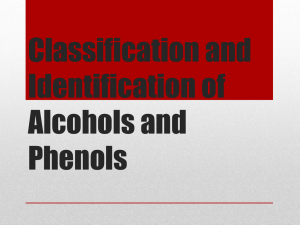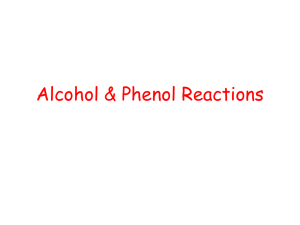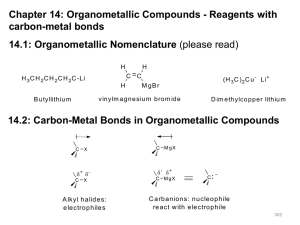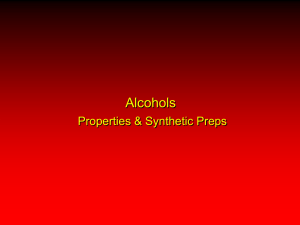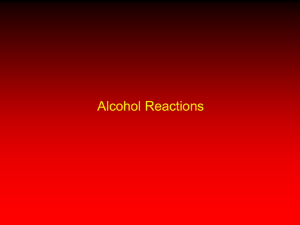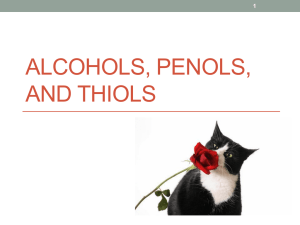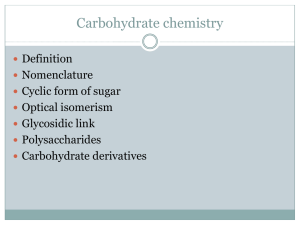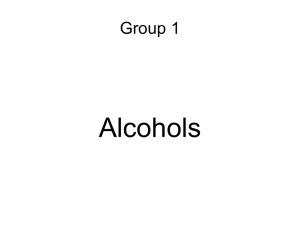OR Practice Problem - HCC Southeast Commons
advertisement
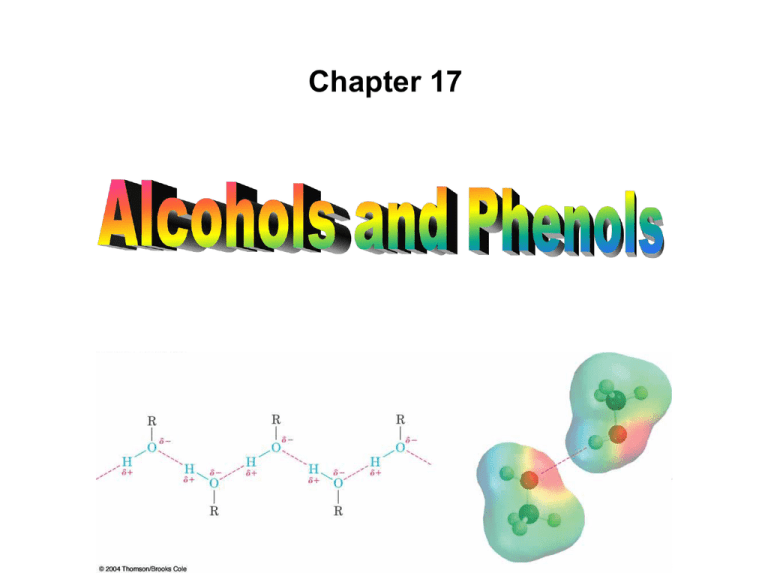
Chapter 17 Introduction • Alcohols are compounds with a OH group bonded to a saturated C (sp3-hybridized) • Phenols are compounds with a OH group bonded to a carbon in a benzene ring • Alcohols are abundant in nature; they are important solvents and synthesis intermediates – Methanol, CH3OH, called methyl alcohol, is a common solvent, a starting material and a fuel additive; it is produced in large quantities by catalytic reduction – Ethanol, CH3CH2OH, called ethyl alcohol, is a solvent, fuel, beverage; it is produced in large quantities by acidcatalyzed hydration of ethylene • Phenol, C6H5OH (“phenyl alcohol”) is abundant in nature; it has diverse uses – It gives its name to the general class of compounds flavoring agent (oil of wintergreen) allergens (poison oak or ivy ) 1. Naming Alcohols and Phenols • Alcohols are classified as primary (1°), secondary (2°), or tertiary (3°) based on substitution on C to which OH is attached – Primary (1°) (C has two H’s, one R) – Secondary (2°) (C has one H, two R’s) – Tertiary (3°) (C has no H, 3 R’s) Naming Alcohols • Alcohols are named according to the IUPAC system 1. Select the longest carbon chain containing the OH group, and derive the parent name by replacing the -e ending of the corresponding alkane with -ol 2. Number the chain from the end nearer the OH group 3. Number substituents according to position on chain, listing the substituents in alphabetical order • Many alcohols have common names, accepted by IUPAC Naming Phenols • Phenols are named according to the IUPAC system 1. Use “phene” (the French name for benzene) as the parent hydrocarbon name, not benzene, followed by the suffix –ol to indicate the OH substituent 2. Number substituents on aromatic ring by their position from OH Practice Problem: Give IUPAC names for the following compounds Practice Problem: Draw structures corresponding to the following IUPAC names a. 2-Ethyl-2-buten-1-ol b. 3-Cyclohexen-1-ol c. trans-3-Chlorocycloheptanol d. 1,4-Pentanediol e. 2,6-Dimethylphenol f. o-(2-Hydroxyethyl)phenol 2. Properties of Alcohols and Phenols: Hydrogen Bonding • The geometry around the O atom of an alcohol (ROH) and phenol (ArOH) is similar to that of water (HOH) – The C-O-H bond angle has the tetrahedral value – The O atom is sp3-hybridized • Alcohols and phenols have much higher boiling points than alkanes and alkyl halides with similar MW • Alcohols and phenols have high boiling points because they form hydrogen bonds (like H2O) in solution – A hydrogen bond is a weak attraction between a H bonded to an electronegative atom and an electron lone pair on another electronegative atom – This intermolecular force elevates the boiling point – The attraction of a d+ H atom of OH from one molecule to a lone pair of electrons on a d- O atom of another molecule produces a force that holds the two molecules together – This intermolecular attraction (present in solution but not in the gas phase) must be overcome for the molecules to enter the gas phase, thus elevating the boiling point of the solution Practice Problem: The following data for isomeric four-carbon alcohols show that there is a decrease in boiling point with increasing substitution. How might you account for this trend? 1-Butanol, bp 117.5oC 2-Butanol, bp 99.5oC 2-Methyl-2-propanol, bp 82.2oC 3. Properties of Alcohols and Phenols: Acidity and Basicity • Alcohols and phenols are both weakly basic and weakly acidic – They act as Brønsted bases in the presence of a strong acid – They act as Brønsted acids in the presence of a strong base • Alcohols and phenols are weak Brønsted bases – They are protonated by strong acids to yield oxonium ions, ROH2+ • Alcohols and phenols are weak Brønsted acids – They can transfer a proton to water to a very small extent – They produce H3O+ and an alkoxide ion, RO-, or a phenoxide ion, ArO- Brønsted Acidity Measurements • The acidity constant, Ka, measures the extent to which a Brønsted acid transfers a proton to water HA + H2O A- + H3O+ [A-] [H3O+] Ka = Keq [H2O] = ————— [HA] • A larger value of Ka indicates a stronger acid pKa – The acid strength scale • Acid strength is expressed using pKa values: pKa = - log Ka • The free energy in an equilibrium is related to -ln of Keq: DG = -RT ln Keq • Relative acidities are more conveniently presented on a logarithmic scale, pKa, which is directly proportional to the free energy of the equilibrium • Differences in pKa correspond to differences in free energy DpKa = log Keq2/Keq1 DpKa can be used to calculate the extent of H+ transfer • H+ will always go from the stronger acid to the stronger base • The stronger the acid, the weaker its conjugate base. The weaker the acid, the stronger the conjugate base. The larger the Ka, the smaller the pKa, the stronger the acid Alcohol Acidity • Simple alcohols are about as acidic as water – – – • pKa H2O = 15.74 pKa CH3OH = 15.54 pKa CH3CH2OH = 16.00 Factors that affect alcohol acidity include: – Alkyl Substitution (Steric Effects) – Inductive Effects Effect of Alkyl Substitution – Higher alkyl groups decrease the acidity of an alcohol due to decreased solvation of the alkoxide ion • – The less easily the alkoxide ion is solvated by water, the less stable, the less its formation is energetically favored, the lower the acidity Steric hindrance on alkoxide ion decreases solvation – Steric hindrance on alkoxide ion decreases solvation CH3OH has an unhindered O on the methoxide ion, CH3O(CH3)3OH has a hindered O on the t-butoxide ion, (CH3)3O- Inductive Effects – Electron-withdrawing groups make an alcohol a stronger acid by stabilizing the conjugate base (alkoxide) Nonafluoro-t-butoxide ion t-butoxide ion Alcohols generate alkoxides • Alcohols are weak acids. They require a strong base • They form alkoxides upon reaction with: – – – – • alkali metals, sodium hydride (NaH), sodium amide (NaNH2), and Grignard reagents (RMgX) Alkoxides are used as basic reagents in organic chemistry Alcohols form alkoxides upon reaction with: alkali metals, NaH, NaNH2, and Grignard reagents (RMgX) Phenol Acidity • Phenols (pKa ~10) are much more acidic than alcohols (pKa ~ 16) due to resonance stabilization of the phenoxide ion • The resonance-stabilized phenoxide anion is more stable than the methoxide anion. The negative charge in phenoxide is delocalized (spread over) from O to the ring. • Phenols react with NaOH solutions (but alcohols do not), forming salts that are soluble in dilute aqueous solutions • A phenolic component can be separated from an organic solution by extraction into basic aqueous solution followed by addition of acid into the solution Effect of Substitution on phenol acidity Substituted phenols can be more or less acidic than phenol itself – An electron-withdrawing substituent makes a phenol more acidic because it delocalizes the negative charge – An electron-donating substituent makes a phenol less acidic because it concentrates the charge Nitro phenols – Phenols with nitro groups at the ortho and para positions are much stronger acids – The pKa of 2,4,6-trinitrophenol is 0.6, a very strong acid Practice Problem: Is p-cyanophenol more acidic or less acidic than phenol? CN, an electron-withdrawing group, increases the acidity of phenol by stabilizing the negative charge on the phenoxide ion. Practice Problem: Rank the following substances in order of increasing acidity: a. (CH3)2CHOH, HCCH, (CF3)2CHOH, CH3OH b. Phenol, p-methylphenol, p-(trifluoromethyl)phenol c. Benzyl alcohol, phenol, p-hydroxybenzoic acid Practice Problem: p-Nitrobenzyl alcohol is more acidic than benzyl alcohol but p-methoxybenzyl alcohol is less acidic. Explain 4. Preparation of Alcohols: A Review • Alcohols are very useful in synthesis because: – They can be derived from many types of compounds – They can be converted to many other types of compounds (with different functional groups) Preparation of Alcohols by Regiospecific Hydration of Alkenes • Hydroboration/oxidation: syn, non-Markovnikov hydration • Oxymercuration/reduction: Markovnikov hydration Preparation of 1,2-Diols • Cis-1,2-diols: Hydroxylation of an alkene with OsO4 followed by reduction with NaHSO3 • Trans-1,2-diols: Acid-catalyzed hydrolysis of epoxides • There is a new nomenclature for cis and trans diols: – – Select a reference substituent r (with lowest sequence number or with higher Cahn-Ingold-Prelog priority) Assign the other either cis (c) or trans (t) to the reference 1-methyl-r1,c2-cyclo-hexanediol 1-methyl-r1,t2-cyclo-hexanediol Practice Problem: Predict the products of the following reactions: (c) cis-5-decene 1. OsO4 2. NaHSO3 ? 5. Alcohols from Reduction of Carbonyl Compounds • Reduction of a carbonyl compound in general gives an alcohol – Note that organic reduction reactions add the equivalent of H2 to a molecule Reduction of Aldehydes and Ketones • • Aldehydes are reduced to give primary alcohols Ketones are reduced to give secondary alcohols Reduction Reagent: Sodium Borohydride (NaBH4) • NaBH4 is not sensitive to moisture and it does not reduce other common functional groups – It adds the equivalent of “H-” Reduction Reagent: Lithium Aluminum Hydride (LiAlH4) • LiAlH4 is more powerful, less specific, and very reactive with water – Like NaBH4, it adds the equivalent of “H-” Reduction of Carboxylic Acids and Esters • Carboxylic acids and esters are reduced to give primary alcohols – LiAlH4 is used because NaBH4 is not effective for carboxylic acids and esters Reduction Reagent: Lithium Aluminum Hydride (LiAlH4) • LiAlH4 is used because NaBH4 is not effective – It adds the equivalent of two “H-” Mechanism of Reduction • The mechanism involves: – Addition of nucleophilic hydride ion, H-, to the positively polarized electrophilic carbon of C=O to form an alkoxide ion intermediate – Protonation of the alkoxide ion intermediate Practice Problem: What carbonyl compounds would you reduce to obtain the following alcohols? Practice Problem: What reagent would you use to accomplish each of the following reactions? Practice Problem: What carbonyl compounds give the following alcohols on reduction with LiAlH4? Show all possibilities 6. Alcohols from Reaction of Carbonyl Compounds with Grignard Reagents • Alkyl, aryl, and vinylic halides react with Mg in ether or THF to generate Grignard reagents, RMgX • Grignard reagents react with carbonyl compounds to yield alcohols Grignard addition to carbonyl compounds • Formaldehydes react with Grignard reagents to give primary alcohols Formaldehyde • Aldehydes react with Grignard reagents to give secondary alcohols • Ketones react with Grignard reagents to give tertiary alcohols Examples of Reactions of Grignard Reagents with Carbonyl Compounds • Esters react with Grignard reagents to give tertiary alcohols in which two of the substituents R on OHbearing carbon come from the Grignard reagent • Grignard reagents do not add to carboxylic acids – Base They undergo an acid-base reaction, generating the hydrocarbon of the Grignard reagent and the carboxylic acid salt + Acid Hydrocarbon + Salt Limitations of the Grignard Reaction • Grignard reagents can't be prepared from alkylhalides if there are reactive functional groups, FG, in the same molecule, including proton donors: Mechanism of the Addition of a Grignard Reagent • There are two steps: – Grignard reagents act as nucleophilic carbon anions (carbanions, : R-) in adding to a carbonyl group – The intermediate alkoxide is then protonated to produce the alcohol Practice Problem: How would you use the addition of a Grignard reagent to a ketone to synthesize 2-phenyl-2propanol? Practice Problem: How would you use the reaction of a Grignard reagent with a carbonyl compound to synthesize 2-methyl-2-pentanol? OR Practice Problem: Show the products obtained from addition of methylmagnesium bromide to the following compounds: a. Cyclopentanone b. Benzophenone (diphenyl ketone) c. 3-Hexanone Practice Problem: Use a Grignard reaction to prepare the following alcohols: a. 2-Methyl-2-propanol b. 1-Methylcyclohexanol c. 3-Methyl-3-pentanol d. 2-Phenyl-2-butanol e. Benzyl alcohol Practice Problem: Use the reaction of a Grignard reagent with a carbonyl compound to synthesize the following compound: 7. Some Reactions of Alcohols • There are two general classes of alcohol reactions: – At the carbon of the C–O bond – At the proton of the O–H bond Dehydration of Alcohols to Yield Alkenes • Dehydration of alcohol involves loss of O-H and H of the neighboring C–H to give a bond (an alkene) • Specific reagents are needed: – Acid catalysts (H3O+) – Phosphorus oxychloride in pyridine (POCl3/pyridine) Acid-Catalyzed Dehydration • Acid-catalyzed dehydration usually follows Zaitsev’s rule – It produces the more stable (more highly substituted) alkene • It is an E1 process with a three-step mechanism: – protonation of the alcohol O – spontaneous loss of H2O to yield a carbocation intermediate – loss of proton H+ from the neighboring carbon • The reactivity order for acid-catalyzed dehydration is: – Tertiary alcohols are readily dehydrated with acid – Secondary alcohols require severe conditions (75% H2SO4, 100°C) - Sensitive molecules don't survive – Primary alcohols require very harsh conditions – Impractical • The reactivity order is the result of the stability of the carbocation intermediate Primary Carbocation < Secondary Carbocation < Tertiary Carbocation Dehydration with POCl3 • Phosphorus oxychloride POCl3 in the amine solvent pyridine can lead to dehydration of secondary 2o and tertiary 3o alcohols at low temperatures • It is an E2 process via an intermediate ester of POCl2: – reaction of the alcohol O with POCl3 to form a dichlorophosphate intermediate – abstraction of H+ by pyridine and loss of OPOCl2 Practice Problem: What product(s) would you expect from dehydration of the following alcohols with POCl3 in pyridine? Indicate the major product in each case. Conversion of Alcohols into Alkyl Halides • 3° alcohols are converted into alkyl halides by HCl or HBr at low temperature SN1 • 1° and 2o alcohols are resistant to acid – They are converted into alkyl halides by SOCl2 or PBr3 SN2 • The reaction of 3o alcohol with HX occurs by an SN1 mechanism: – protonation of the alcohol O – spontaneous loss of H2O to yield a carbocation intermediate – Attack by nucleophilic halide ion on the carbocation • The reactions of 1o and 2o alcohols with SOCl2 or PBr3 occur by SN2 mechanisms: – Reaction of SOCl2 or PBr3 converts the OH into OSOCl or OPBr2 (better leaving groups than OH) – Backside nucleophilic substitution of Cl- or Br- expels OSOCl or OPBr2 Conversion of Alcohols into Tosylates • Alcohols react with p-toluenesulfonyl chloride (tosyl chloride, p-TosCl) in pyridine to yield alkyl tosylates, ROTos – Formation of the tosylate does not involve the C–O bond so configuration at a chirality center is maintained – Alkyl tosylates behave like alkyl halides (SN1 and SN2 reaction) • Stereochemical Uses of Tosylates – The SN2 reaction of an alcohol via an alkyl halide proceeds with two inversions, giving product with same absolute stereochemistry as starting alcohol – The SN2 reaction of an alcohol via a tosylate, produces one inversion at the chirality center, giving product with opposite absolute stereochemistry to starting alcohol Practice Problem: How would you carry out the following transformation, a step used in the synthesis of (S)-ibuprofen? 8. Oxidation of Alcohols • Alcohols undergo oxidation reactions to yield carbonyl compounds • • • Primary alcohols yield aldehydes or carboxylic acids Secondary alcohols yield ketones Tertiary alcohols do not react with oxidizing agents • The oxidation of primary and secondary alcohols can be accomplished by inorganic reagents, such as KMnO4, CrO3, and Na2Cr2O7 or by more selective, expensive reagents Oxidation of Primary Alcohols • Primary alcohols are converted to – aldehydes via pyridinium chlorochromate (PCC, C5H6NCrO3Cl) in dichloromethane – carboxylic acids via other reagents (CrO3, …) Oxidation of Secondary Alcohols • Secondary alcohols are converted to ketones – This is effective with inexpensive reagents such as Na2Cr2O7 in acetic acid – PCC is used for sensitive alcohols at lower temperatures Mechanism of Chromic Acid Oxidation • It is an E2-like mechanistic pathway: – • Alcohol reacts with Cr(VI) to form a chromate ester followed by elimination of H+s and expulsion of Cr (the leaving group) to give carbonyl product The mechanism was determined by observing the effects of isotopes on rates Practice Problem: What alcohols would give the following products on oxidation? Practice Problem: What products would you expect from oxidation of the following compounds with CrO3 in aqueous acid? With pyridinium chlorochromate? a. 1-Hexanol b. 2-Hexanol c. Hexanal 9. Protection of Alcohols • Hydroxyl groups can easily transfer their proton to a basic reagent – This can prevent desired reactions • Converting the hydroxyl to a (removable) functional group without an acidic proton protects the alcohol • When one functional group in a molecule interferes with an intended reaction, it is possible to avoid the problem by protecting the interfering functional group by: 1. introducing a protecting group to block the interfering function 1. carrying out the desired reaction 1. removing the protecting group Common Method to Protect Alcohols • Reaction with chlorotrimethylsilane in the presence of base yields an unreactive trimethylsilyl (TMS) ether – The base (usually triethylamine) helps to form the alkoxide anion and to remove the HCl by-product • The ether can be cleaved with acid or with fluoride ion to regenerate the alcohol – The ether has no acidic H’s and is protected from oxidizing agents, reducing agents, and Grignard reagents Protection-Deprotection: An Example • Use of TMS-alcohol protection during Grignard reaction of 3-bromo-1-propanol to acetaldehyde • A nucleophile reacts with Si of TMS via SN2 even though Si is a 3o center – Si is less hindered. It is larger than C and forms longer bonds Practice Problem: TMS ethers can be removed by treatment with fluoride ion as well as by acid-catalyzed hydrolysis. Propose a mechanism for the reaction of cyclohexyl TMS ether with LiF. Fluorotrimethylsilane is a product. 10. Preparation and Uses of Phenols • Phenols can be prepared by: – reaction of chlorobenzene with NaOH at high temperature and pressure – reaction of cumene (isopropylbenzene) with O2, followed by treatment with acid – alkali fusion of aryl sulfonate • Phenol is prepared on an industrial scale by treatment of chlorobenzene with dilute aqueous NaOH at 340°C under high pressure • Another industrial process of phenol synthesis involves readily available cumene and O2/H3O+ – It forms cumene hydroperoxide with O2 at high temperature – It is converted into phenol and acetone by acid (H3O+) • Cumene hydroperoxide is acid-catalyzed to form phenol: – protonation of O – rearrangement of the phenyl group from C to O with simultaneous loss of H 2O – readdition of H2O then yields a hemiacetal intermediate, which breaks down to phenol and acetone • A laboratory preparation of phenols involves melting aromatic sulfonic acids with NaOH at high temperature – It is limited to the preparation of alkyl-substituted phenols • Phenol is the starting material for synthesis of – chlorinated phenols (eg. pentachlorophenol, 2,4-D, hexachlorphene,…) • Phenol is the starting material for synthesis of – food preservatives BHT (butylated hydroxytoluene) and BHA (butylated hydroxyanisole) Practice Problem: p-Cresol (p-methylphenol) is used both as an antiseptic and as a starting material to prepare the food additive BHT. How would you prepare p-cresol from benzene? Practice Problem: Show the mechanism of the reaction of pmethylphenol with 2-methylpropene and H3PO4 catalyst to yield the food additive BHT 11. Reactions of Phenols • Phenols can undergo: – Electrophilic Aromatic Substitution Reactions – Oxidations Electrophilic Aromatic Substitution Reactions • The hydroxyl group is strongly activating, ortho- and para-directing • Phenols are highly reactive substrates for electrophilic aromatic reactions: – halogenation, – nitration, – sulfonation, and – Friedel–Crafts reactions Oxidation of Phenols: Quinones • Reaction of a phenol with strong oxidizing agents yields a quinone (or 2,5-cyclohexadiene-1,4-dione) – Fremy's salt [(KSO3)2NO, potassium nitrosodisulfonate] works under mild conditions through a radical mechanism Oxidation-reduction of quinones • Quinones can be easily reduced to hydroquinones (p-dihydroxybenzenes) by NaBH4 or SnCl2 • Hydroquinones can be easily reoxidized to quinones by Fremy's salt Quinones in nature • Ubiquinones, also called coenzymes Q, mediate electron-transfer processes involved in energy production through their redox reactions 12. Spectroscopy of Alcohols and Phenols • Alcohols and phenols can be identified by – Infrared Spectroscopy – Nuclear Magnetic Resonance Spectroscopy – Mass Spectrometry Infrared Spectroscopy • Alcohols have a characteristic O–H stretching absorption at 3300 to 3600 cm-1 in the IR spectrum – Sharp absorption near 3600 cm-1 except if H-bonded: then broad absorption 3300 to 3400 cm-1 range – Strong C–O stretching absorption near 1050 cm-1 Cyclohexanol • Phenol OH absorbs near 3500 cm-1 Practice Problem: Assume that you need to prepare 5-cholestene3-one from cholesterol. How could you use IR spectroscopy to tell whether the reaction was successful? What differences would you look for in the IR spectra of starting material and product? Nuclear Magnetic Resonance Spectroscopy • 13C NMR: C bonded to electron-withdrawing -OH is deshielded and absorbs at a lower field, d 50 to 80 • • 1H NMR: H bonded on the O-bearing C is deshielded by electron-withdrawing effect of the nearby O; it absorbs at d 3.5 to 4.5 – Usually no spin-spin coupling between O–H proton and neighboring protons on C due to exchange reactions with moisture or acids – Spin–spin splitting is observed between protons on the oxygen-bearing carbon and other neighbors Phenol O–H protons absorb at d 3 to 8 – Usually no spin-spin coupling between O–H proton and neighboring protons on C due to exchange reactions with moisture or acids Adding D2O makes the OH proton absorption disappear – Spin–spin splitting is observed between protons on the oxygen-bearing carbon and other neighbors Example: 1-propanol Practice Problem: When the 1H NMR spectrum of an alcohol is run in DMSO solvent rather than chloroform, exchange of the OH proton is slow and spinspin splitting is seen between the OH proton and CH protons on the adjacent carbon. What spin multiplicities would you expect for the hydroxyl protons in the following alcohols? a. 2-Methyl-2-propanol d. 2-propanol b. Cyclohexanol e. Cholesterol c. Ethanol f. 1-Methylcyclohexanol Mass Spectrometry • Alcohols undergo: – alpha () cleavage, a C–C bond nearest the hydroxyl group is broken, yielding a neutral radical plus a charged oxygen-containing fragment – dehydration, loss of H-OH yielding an alkene radical cation – alpha () cleavage: a C–C bond nearest the hydroxyl group is broken, yielding a neutral radical plus a charged oxygen-containing fragment – Dehydration: loss of H-OH yielding an alkene radical cation • Example: Mass spectrum of 1-butanol Chapter 17
